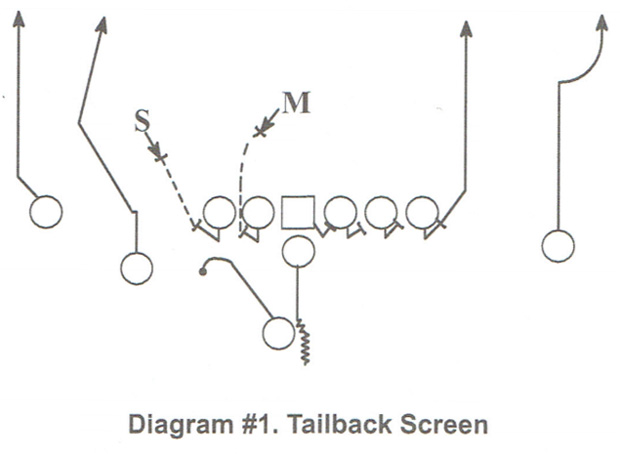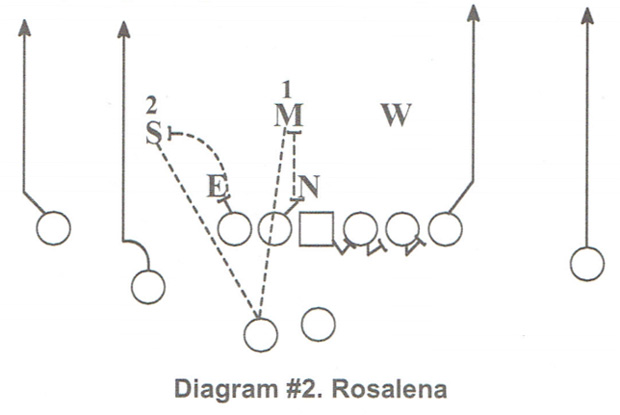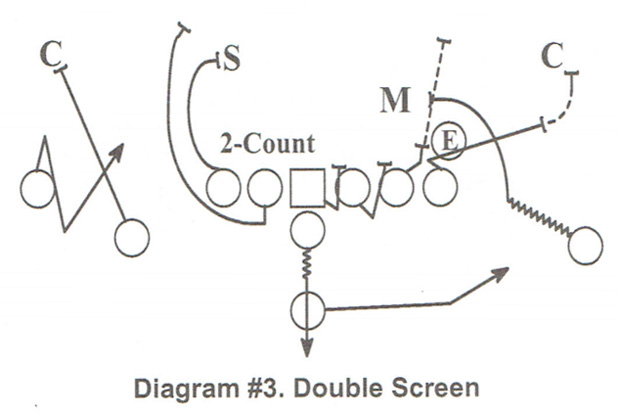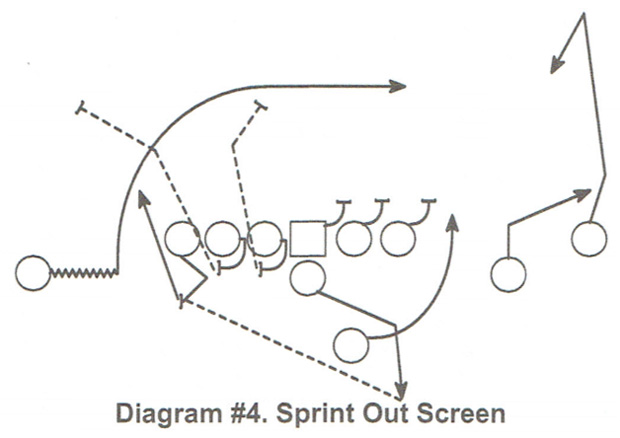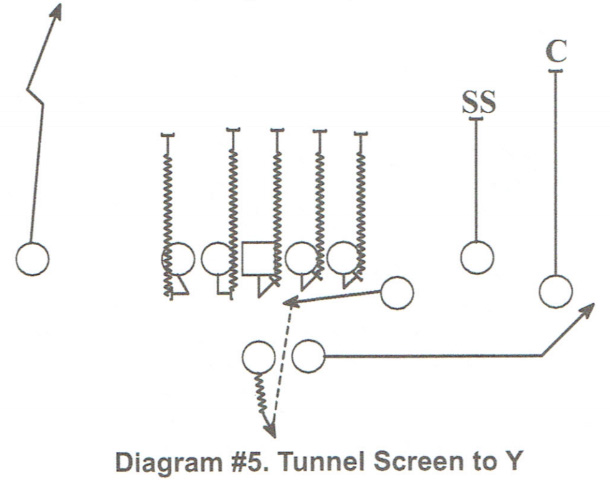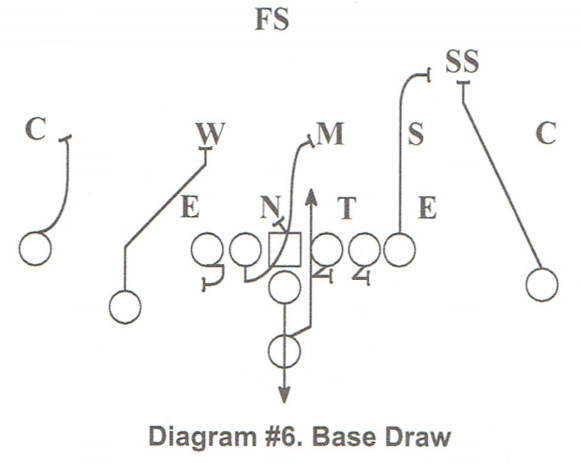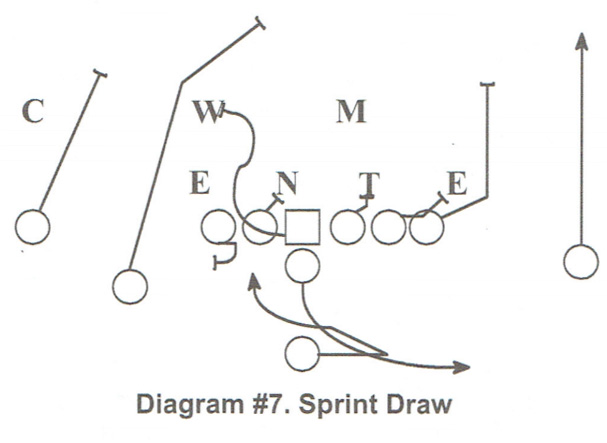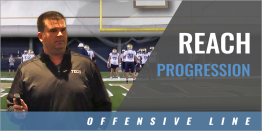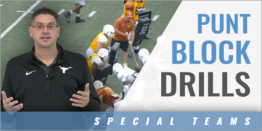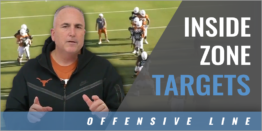| Screen and Draw Packages |
| By: Stefan LeFors - Christian Academy of Louisville (KY)
Originally Published in: Nike 2017 Coach of the Year Clinics - by Earl Browning Provided by: Nike Coach of the Year • School started 1998 • Class 2A • Just finished 6th year at Cal • Why I coach • Style of offense • Multiple personnel groupings • Multiple formations I want to start off and give you some background about Christian Academy. We are located in the east end of Louisville along the 165 interstate. The program is a fairly new program started in 1998 and has had a little bit of success. In the six years that I have been there, we have enjoyed a lot of success. I want to give that credit to the assistant coaches. Not only the coaches at our level but our feeder program coaches. In our feeder program, we have tackle football started in the first grade, pee wees, juniors, and finally the varsity program. We have a lot of good coaches and volunteers that have put in a lot of time. Before I get any further, we have a crew of assistant coaches down in Tunica, Mississippi attending a coaching clinic down there. I want to give a shout out to a fellow Louisiana brother down there. I want to get into why I got into coaching. I played football when I was a little guy coming up. I was fortunate enough to go on to high school and later to college playing football. I played right here at the University of Louisville. I got a shot to go on and play pro football, which was a lot of hard work. When it came time to hang'em up, I did not know what I wanted to do. I love the game of football and still wanted to be a part of it in some way. I always loved being around young people and decided to give coaching a shot. I had a high school coach that had an impact on me. He played quarterback at Middle Tennessee State and helped me get where I have gotten today. I want to thank you guys for what you do. I work in the athletic department at Christian Academy. At the beginning of each season, we have a coach's meeting. We just had our spring coaches meeting. At these meetings we talk about the policies, scheduling, fund raising and all the things we have to do. At these meetings. we bring in a speaker to challenge the coaches to do their best. Steve Wiggenton, who runs the FCA here in Louisville, came and spoke to the coach. He told a story about a head coach that had a football player that passed away. The parents had two request of the head coach. One of the request made by the family to his high school coach was that he be buried in his uniform. That was no problem. The parents also asked the coach to deliver the eulogy at the funeral. The coach was taken back by the request. He volunteered to get the pastor at the church or the youth leader at the church who was more qualified to do that. They told the coach, he was their son's pastor and leader. You fill the same role with your players. You are their pastor and leader. We wear our kids out at practice because they took the wrong step or blocked the wrong man. We wear them out on the field, but after the practice we are the ones who take an interest in that kid and his life. We are the ones that puts the arm around his shoulder and asked how his mom is doing. Those players know that we care about and love them. As far as the style of offense we run at Christian Academy, I do not know what we are. I know what we are not. We are not a wing-T team, veer, or strictly spread. We are multiple in every way. I played for Coach Petrino at University of Louisville. A lot of the terminology and schemes are what we do at Christian Academy. We were very successful at Louisville and I believe in that system. We do a lot of the same things we did at Louisville. I am blessed to have extremely smart players. We are like every other team in that we have some knuckleheads but for the most part our players are very smart. We use many personnel groups and try to get as many players involved as we can. Within those groupings we are very multiple in our formations. As the season progresses, we end up concentration on fewer personnel groups. Whatever our players are best suited for is what we run. Why We Throw Screens • Counter today's attacking and blitzing defensive philosophy • Easy completion for a quarterback (confidence) • Get the ball to your best athlete in space • Big play potential • Slow down the pass rush • Can be called in many different situations In today's football, teams like to bring a lot of heat and pressure in their schemes. They want to pressure you and attack from all different areas. The screen play is a good counter to that type of philosophy. The screen is an easy completion for the quarterback. I can testify to that fact. I started as a freshman for my high school team. I was little and probably weight 150 pounds soaking wet. My coach knew to get me started, I had to get a couple of easy completion. We had two good running backs. I threw for about 1500 yards as a freshman and the majority of the completions were screens. If your quarterback is struggling early in the game, throw the screen pass to get him going. It does not have to be a big yardage play but to see the completion builds confidence in the quarterback. The plays put the ball in the hands of your playmaker in space. The screen can be a big play. It is hard to tackle a good athlete in the open field. The screen play will slow down the pass rush. If the defense is gashing the quarterback, a couple of screen passes will slow them down. That is particularly true if the screens end up being big plays. Football is a game of inches and seconds. Slowing the pass rush can be the difference between a sack, a fumble and a touchdown off a double move. That split second the defense slowed down because of the screen can be huge. The screen is not a situational throw. You can throw the screen in any situation and any field position. You cannot just call the screen or draw in a third down situation. For it to be an effective play, you must throw it on any down in any situation. Call the screen on first down, second and short, backed up to the end zone, or in the red zone going in. When you come to clinics, you get a million ideas. You get schemes, plays, and drills but you must remember that the people talking about those things are running them. The timing in when these plays are called is what makes them work. Plays are not magic. The screens I am going to show you are not magical. The key to running the screen is when you call it. If you call the play at the right time and execute, you will have a successful play. Execution • Quarterback drills • Term screen period • Reps, reps, reps As part of the quarterback's warmup period every day, we include some drills that benefits the screen. When you throw the screen pass, the quarterback uses some technique that is not normally used in a quarterback's fundamental throwing position. He has to throw the ball while going backward. He has to make off balanced throw and use all kinds of mechanic's he does not use in a standard drop back pass. We work a drifting movement, with different throwing angles for the arm. If you watch Aaron Rogers and quarterback like that, you will see them throw over defender and around them. They can throw the ball side armed or underhanded. They are good at throwing those types of passes because they work on them in practice. When we run the team screen period, we do it on air with no defense. We set cones up for the linemen's landmarks and their spacing. The screen blocking deals with spacing. Spacing for linemen comes on the run. You do not want linemen standing on top of the back or another blocker. pacing and timing comes from repetitions. If you work against the scout team that is not really rushing the quarterback, all they do is screw up the play. That is why we work the screen game on air. The key to being a great screen team is to rep it. You have to make it part of your daily practice plan. You have to do it repeatedly. The first screen we run comes from a gap protection scheme for the offensive linemen. (Diagram #1) We use the same protection in our screens as we do with our regular pass protection. We can run the screens right or left equally well from our formations. Our eleven personnel group is called "ace." We can run it out of multiple formations. You should run it out of the formation that gives you the best chance to be successful against the defense you are facing.
The quarterback can be under the center or in the shotgun. If he is under center, he takes five steps and sets up. We want him to look to the opposite side of the screen. The offensive line is in a slide protection to the right. The center, right guard, and right tackle are blocking for the pass. They are not involved in the screen. The left tackle and guard block for two counts and release to the outside. The tackle pulls to the outside looking for the first defender to show. The guard releases outside but upfield looking for the inside linebacker. We tell the receiver to blocking when the defender recognizes the screen. If they are facing man coverage, they want to run the defender out of the play. If they are facing zone coverage, they run the defender off until he recognizes the play. When that happens we stalk block on him. If the quarterback is under the center, the running backs depth is seven yards. However, on the screen we want him to cheat up one yard. On the snap of the ball he sprints out of that position to his blocking assignment, which is opposite the slide of the offensive line. He sprints to the line and settles into position behind the left tackle. The running back is going to strike his blocking assignment, which is generally the defensive end or linebacker coming off the edge. It does not matter what the charge of the defender is. If the defender attacks outside, the running back strikes him and pivots back inside to receiver the ball. If the defender goes inside, he strikes and falls back into position. We had a good tight end the last couple of years. He generally got double coverage. When he released down field, he usually took two defenders with him. The next screen we ran came off our "rose" blocking pattern. If it was a straight drop back pass, the center, right guard, and right tackle, blocked slide protection to the right. The left guard and tackle were in man protection. The protection was a half slide protection. In this protection, the running back had to check for linebacker blitzes'. He read inside out. He checked the Mike linebacker and the outside linebacker in his protection reads. The screen from this blocking scheme was called "Rosalena." (Diagram #2) The difference in this screen is it keeps the back inside and off the edge. If the defense has a good defensive end, this seems to work better. If the tackle works out to the end, it becomes a better play for us. This keeps big on big's and the running back inside.
The action of the receivers and quarterback mechanics remain the same. We can run the play to the right or the left. This next screen is my favorite. We call it "double screen." (Diagram #3) We ran this at Louisville all the time. We had Michael Bush. He was a freshmen my junior year. This is a swing screen to the running back. It gave teams fits. We had a 250-pound running back coming downhill on a corner. I liked that matchup. To the backside we ran a tunnel screen with the two outside receivers.
On this play, the wide receiver cracked on the outside linebacker. The quarterback keyed the defensive end coming off the edge. If the defensive end attacks him, he dumps the ball to the running back on the swing pattern. If the defensive end read the screen and picked up the running back. The quarterback set up and threw the tunnel screen to the wide side of the field. We like to move the flanker in motion back to the front so he can get a good angle at the inside linebacker. The tight end wants to avoid the defensive end so the quarterback can get a good read on him. The tight end releases outside and upfield one step and comes flat down the line of scrimmage. He is looking to block the corner. If the corner is backed off, he turns upfield and stalks the corner. When we throw this screen, we always go to the dominate hand of the quarterback. If the quarterback is right-handed, we throw this play to the right. In my case, I was left-handed and we always threw this to the left. It is easier for the quarterback with his mechanics and footwork to throw to his dominate hand. We only run this play into the short side of the field. With the high school hash marks being so wide, we can run it five yards inside the hash marks. The double screen is the swing screen to the right and a bail out tunnel screen into the wide side of the field. Because the play happens so fast, the quarterback in his drop often times does not set his feet. He takes his five step drop, but may release the ball anywhere in that drop or continue to drop and throw the ball. This has been a good screen for us. If we can get it called at the right time and right situations, it leads to big yardage. The X-receiver to the left wants to cut his split down so the throw is not a long throw. He takes three quick steps up the field to get the corner to move backward. He retraces his steps and comes inside the block of the slot receiver on the corner. The slot back has to know how the corner is playing to get the proper angle on his block. If he is off, the slot can junction him down the field. If the corner is tight or pressed, the slot has to go flat to pick him off. The left tackle and guard block for two counts, release, and get outside. The tackle looks for the first shirt outside and the guard looks for the first threat to the inside. The running back does not get much depth from his original alignment. We want the ball thrown forward. He cannot give ground backward. He has to get his head around immediately because the ball may be thrown quickly. The throw to the running back is an easy throw. Where you must spend time with the quarterback is the throw to the tunnel screen side. Often times the quarterback cannot set his feet because of the pressure. If he can set his feet, he can use the proper mechanics to get the ball thrown to the left. We want to throw the ball to the running back as often as we can. The quarterback has to make the decision. However, if he feels the end cannot make a play on the running back, he throw it to him even though the end is not attacking him. In our offense, we sprint the quarterback out to change the launch points of his throws. We sprint right or left. On this screen we sprint out to the right and throw back left to the tight end. (Diagram #4) On this play, the center, right guard, and right tackle are gapping to the right. The running back has to block the edge rusher to that side. The tight end is away from the sprint action. The flanker to the screen side wants to come in motion to the set and drive across the deep middle of the field, hoping to take the coverage or safety with him. The left guard and tackle are the escorts on this play. They set and invite the rush to go inside. When the defender rush to the inside, the blockers wash them down inside and release into the screen.
We have not had to throw the ball to the two-receiver side, but we are prepared to throw it that way. We run a curl/flat type of pattern with the flanker and slot back. If we throw the ball to the sprint-out side, we want to throw it to the slot quickly. That prevents you from getting a flag for illegals down field. We only throw this screen to the left. We always sprint to the right and throw back. It is easier on the quarterback mechanics to do it that way. There are a ton of screens you can run. We run the swing screen into the trips set. That puts three blocker in front of your running back. We throw the "now" screen anytime the defense gives it to us. We throw the bubble screen. Where we have had a lot of success is tagging the screen to the running plays. We do that a lot. With the now screen, the quarterback is raising up and throwing as quickly as he can. He throws the ball with or without the laces. We feel like those types of plays are nothing more than long handoffs. We do not throw many jailbreak screens, but we do use one to the tight end. We call it tunnel screen to "Y." (Diagram #5)
We try to make this look like the swing screen to the running back. The wide receiver goes down field as if they were stalk blocking on the corner and safety. The offensive linemen are trying to wash the defender to the inside and let them penetrate to the quarterback. They are coming off and working down field for the linebackers and defensive back. The tight end from his inside slot position comes inside and catches the ball in the center to right guard area. We run a couple of basic draw plays. We can run the draw from under the center and in the shotgun. (Diagram #6) If we are under the center, the quarterback takes the snap, shows the ball, then takes an open step, cross over step, and hands the ball off on the third step. If he is in the gun, he shows the ball and hands it to the running, who is in the offset position beside him.
The running back takes a lateral step with his play side foot. He has to be patient and let the quarterback bring him the ball. He does not want to move forward toward the quarterback. The play going to the dominate hand of the quarterback is a more fluid play because of the quarterback steps and mechanics. We see more under fronts than anything else. With that type of front, the center blocks back on the 1-technique nose. The backside guard works around the center's block and folds up on the middle linebacker. Everyone else on the line pass sets on the defenders and invites them outside and washes them that way. Depending on the defense, we free release the tight end and get him out of the way. He works up the field and blocks the Sam linebacker. This is not a situational play for us. We will run it on first and ten and not so much on third and long. We do not want to run the play when everyone in the stands is yelling, -Watch the draw!" We like to run the Q-draw. That is the same play except the quarterback is going to carry the ball from the shotgun set. The line blocking is the same. The only difference is the running back is the isolation blocker on the linebacker. The quarterback takes the direct snap, shows pass, and follows the running back into the line. From the sprint series we have a draw to the backside. This is a sprint right, draw left. (Diagram #7) In the line, we want the left guard to block down on the 1-technique defender. The center folds around that block for the linebacker. The left tackle hinges and takes the defensive end deep and rides him to the quarterback.
The running backs steps is a counter action on his part. He takes three steps to his right before planting on his outside foot. He comes underneath the quarterback to receiver the ball. That is between the quarterback and the line of scrimmage. He is looking for the wrap around block by the center. The last thing I want to show you is the "shovel pass." (Diagram #8) You can run this from a number of different formation. I will show it from the trips set left.
When you have defenders charging up the field, this becomes a good play. The quarterback and the running back sell the play to the outside with a sprint action. The tight end comes behind the line of scrimmage and receives a shovel pass from the quarterback. That is all I have. If you want to be a great screen team, you must do the repetitions to get it done. It is up to you how you want to do things. But the key to any offensive play is execution. That execution comes from thousands of reps. I appreciate you coming in to listen. Is there anyone in here with a question? Good luck and God bless. |



